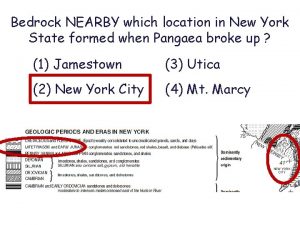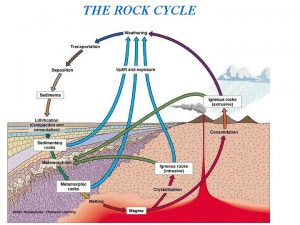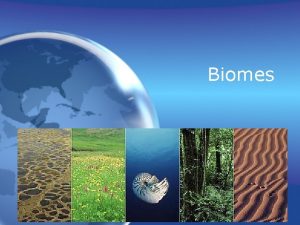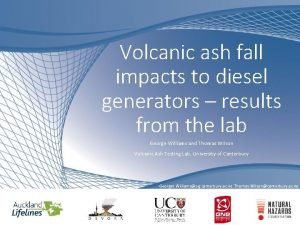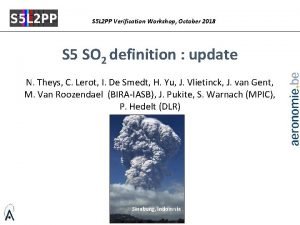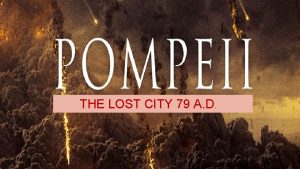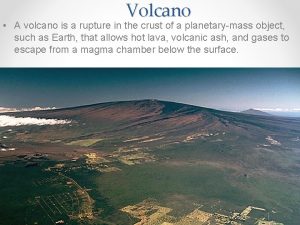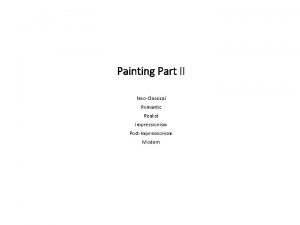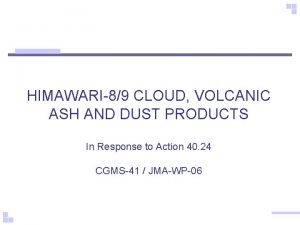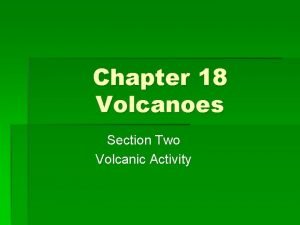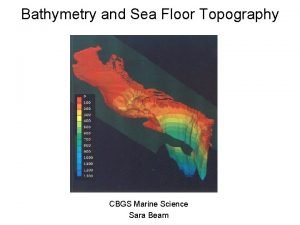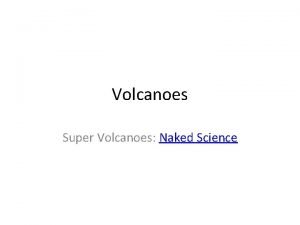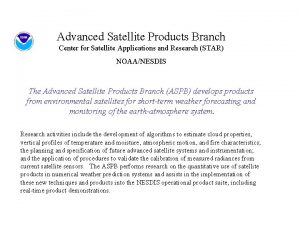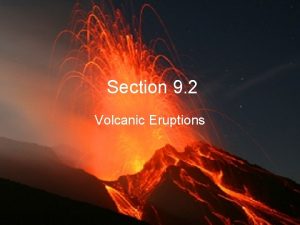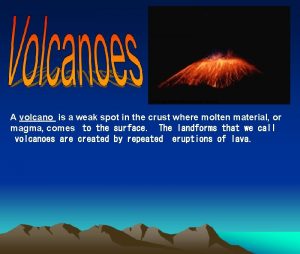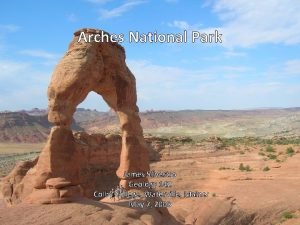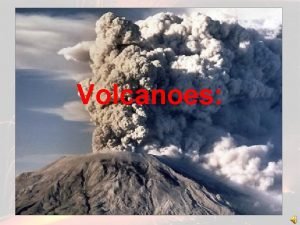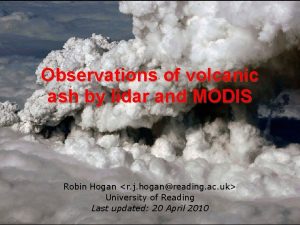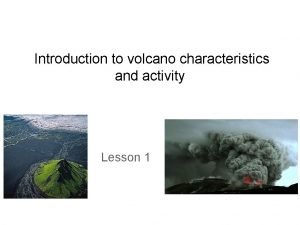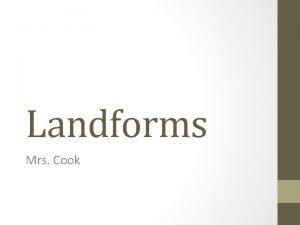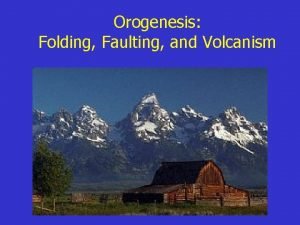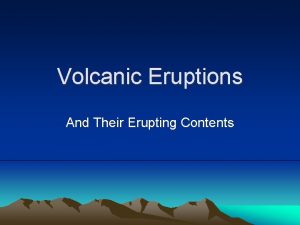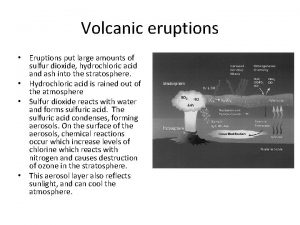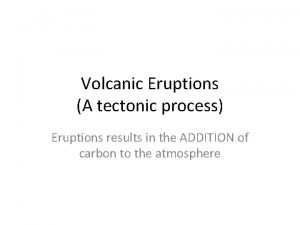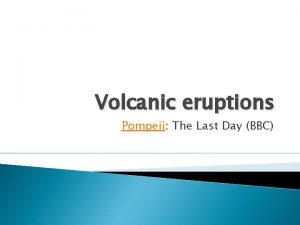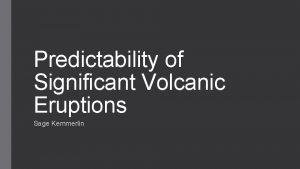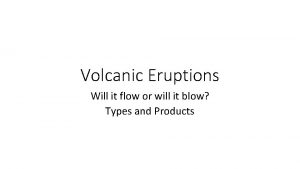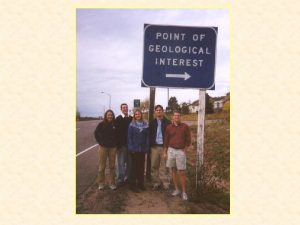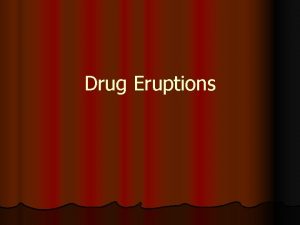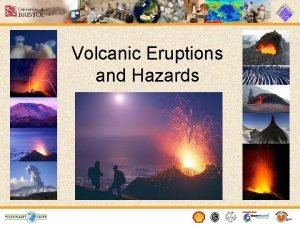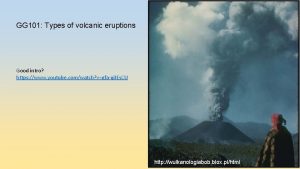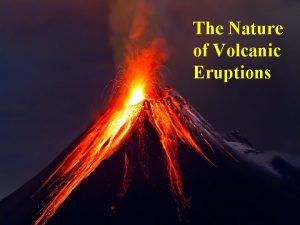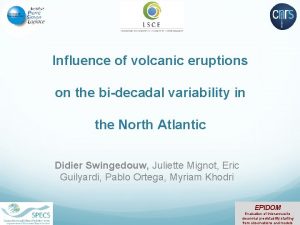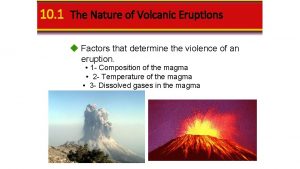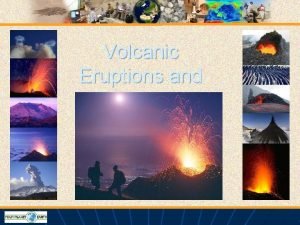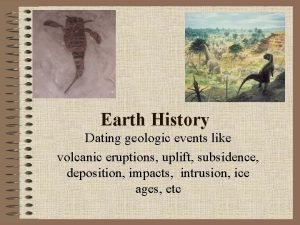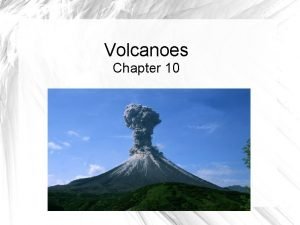Volcanic Eruptions Will it flow or will it



























- Slides: 27

Volcanic Eruptions Will it flow or will it blow? Types and Products

Explosive Eruptions • Less common • More destructive • Mostly produce clouds of hot ash, gas and rock fragments shoot rapidly out of a volcano. • Ash can reach upper atmosphere and stay for years, blocking sunlight • Can blast billions of tons of material • Eg Mount St. Helens

Effusive or Nonexplosive Eruptions • More common • Less destructive • Mostly lava flowing over the Earth’s surface • Most rock on ocean floor was produce by nonexplosive eruptions (Oceanic Volcanoes)

Magma Composition Determines type of Eruption: • Viscosity and dissolved gasses determine the violence of the eruption. • Viscosity is determined by mineral and water composition More water – lava will be less viscous, flows easier (less violent) More gas - means more bubbles (more violent eruptions) More silica – more viscous lava, slower flowing, traps gas (more violent)

Mafic/Basaltic Lava Flow • Darker in colour • high iron and magnesium • low silica content, • Low viscosity due to • Rapid (up to 100 km/hr), Long distance flow – up to 100 s of km • less explosive eruptions - Mafic magma allows gases to escape more easily • Form much of ocean crust • (P and a’a)

Felsic or Rhyolitic Lava Flows • Lighter in colour • Low iron, and magnesium • Highest silica content, • most viscous, rarely flows • Plugs vent as a lava dome • Lower temperature • gases do not escape easily, leading to more explosive eruptions. • Commonly found in continental crust

Intermediate/Andesitic Lava Flows • Intermediate to high viscosity (more Silicon than basalt) moderate amounts of silica, Fe and Mg • Mound near vent, flow slowly • Outer crust fractures, creating rubble • Eg. Mount St. Helens

What comes out of a volcano? Eruptive Material: Lava Flows, Pyroclastic debris, volcanic gases

Eruptive Material: • Gases • Lava • Ash • Tephra (solid airborne fragments).

Gases in Magma • Water vapor, Carbon dioxide, Sulfur, Hydrogen • As magma comes to the surface, the gases are released as bubbles, making the eruption more explosive.

Type of lava formed depends on. . . • Temperature • Composition (minerals and gases) • How it cools

Pahoehoe If lava cools slowly and does not move too fast, it forms smooth ropey lava called pahoehoe.

A’a lava • If lava cools quickly and moves fast it can tear into chunky jagged pieces called a’a. • More common

Blocky Lava • Cool, stiff lava that does not travel very far from the volcano forms piles of rocks with sharp edges. • Larger blocks than a’a lava, and have smoother surface.

Pillow Lava • Forms rounded lumps that look like pillows when it cools underwater.

Columnar • Giant’s Causeway, Northern Ireland.

Tephra – solid airborne fragments • Generic term for any airborne pyroclastic material (solid) • Classified according to size

Volcanic Ash • fine-grained fragments < 2 mm in diameter • Volcanic ash forms when gases trapped in magma or lava form bubbles. • When the bubbles explode, they create millions of tiny pieces.

Volcanic Ash on Plymouth, Monserrat after 1995 Eruption

Hazards Associated with Ash • Daylight turns into darkness. • Roofs may collapse from added weight. • Machinery and vehicles will be abraded. • Farmland will be covered. • Roads will be slippery, blocked, or blocked. • Power systems may shut down. • Waste-water systems may clog. • Gutters may fill and collapse.

Lapilli (Latin for “little stones) Lapilli are small bits of lava that harden before they hit the ground. Pea- to walnut-size pyroclasts (2 -64 mm) All types of lava produces lapilli. All types of volcanoes produce lapilli

Lava Bombs • Large (< 64 mm) blobs of lava ejected while still molten, gaining a streamline shape, harden in the air and cool before they reach the ground. • More rounded

Lava Blocks • Angular fragments ejected when already solid. • larger than 64 mm in diameter • Can be as big as houses

Pyroclastic Flows • Very hot (700ºC), • Very fast (100 km/h), • Current of gas and tephra. • Very dangerous (can destroy everything in its path). • can extend several km from the volcano, and devastate life and property within their paths. • A pyroclastic flow from the eruption of Mount Pinatubo is shown in the figure below. • https: //www. youtube. com/watch? v=EZd. Fqvnz. Cl. U • Play only 1 st minute

Homework • Volcano WS, Questions #1 -7 • Top 10 volcanoes ready to blow: 7. 5 min • https: //www. youtube. com/watch? v=zq. Gsgvc. BSA 4 • Ted Ed colossal consequences 4. 5 min • https: //www. youtube. com/watch? v=h. DNlu 7 Qf 6_E • Research Volcano Project

Other Links • Good description of types of eruptions: • http: //volcano. oregonstate. edu/volcanic-cones-and-eruptionslesson-8 • List of volcanoes: • http: //content. time. com/time/specials/packages/completelist/0, 2 9569, 2014572, 00. html • Video • https: //www. youtube. com/watch? v=RRCQS_Oaevs • https: //www. youtube. com/watch? v=03 NBObzj. J 7 c

Moai of Easter Island It is one of only fourteen moai made from basalt, the rest are carved from the island’s softer volcanic tuff.
 Thin layers of volcanic ash act as excellent time markers
Thin layers of volcanic ash act as excellent time markers Volcanic landform
Volcanic landform The presence of coal in antarctica indicates that
The presence of coal in antarctica indicates that Volcanic formations
Volcanic formations Volcanic landforms diagram
Volcanic landforms diagram Volcanic ash
Volcanic ash Volcanic ash
Volcanic ash Process of volcanic eruption
Process of volcanic eruption Volcanic ash
Volcanic ash Volcanic rupture
Volcanic rupture Volcanic ash
Volcanic ash Factor affecting volcanic eruption
Factor affecting volcanic eruption Volcanic ash
Volcanic ash Volcanic cinder appraisal
Volcanic cinder appraisal Granite diorite gabbro
Granite diorite gabbro Chapter 18 volcanic activity
Chapter 18 volcanic activity Volcanic island arc
Volcanic island arc Cinder cone volcano
Cinder cone volcano Volcanic ash
Volcanic ash Volcanic landform
Volcanic landform Volcanic ash
Volcanic ash James silvestro
James silvestro Volcanic landform
Volcanic landform Volcanic ash
Volcanic ash Volcanic ash
Volcanic ash Tephra
Tephra Volcanic landform
Volcanic landform Define folding faulting and volcanic activity
Define folding faulting and volcanic activity
